
Oglethorpe County is a county located in the northeastern part of the U.S. state of Georgia. As of the 2010 census, the population was 14,899. The county seat is Lexington.

Elbert County is a county located in the U.S. state of Georgia. As of the 2010 census, the population was 20,166. The county seat is Elberton. The county was established on December 10, 1790 and was named for Samuel Elbert.

Girraween National Park is an area of the Granite Belt in the Darling Downs region of Queensland, Australia reserved as a national park. Girraween is known for its spectacular flowers, dramatic landscapes and unique wildlife. Bushwalking and rock climbing are the most popular activities in the park.
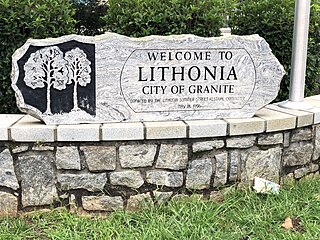
Lithonia is a city in eastern DeKalb County, Georgia, United States. The city's population was 1,924 at the 2010 census. Lithonia is in the Atlanta metropolitan area.
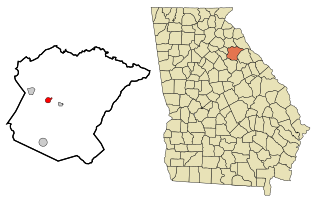
Crawford is a city in Oglethorpe County, Georgia, United States. The population was 807 at the 2000 census.

Stone Mountain is a quartz monzonite dome monadnock and the site of Stone Mountain Park near Stone Mountain, Georgia. At its summit, the elevation is 1,686 feet (514 m) above sea level and 825 feet (251 m) above the surrounding area. Stone Mountain is well known for not only its geology, but also the enormous rock relief on its north face, the largest bas-relief in the world. The carving depicts three Confederate figures, Jefferson Davis, Robert E. Lee and Stonewall Jackson, and has been the subject of widespread controversy.

The Black Rocks is a small outcrop of natural gritstone, between Cromford and Wirksworth in the Derbyshire Peak District, England. Parking is available for walking along the old railway path and up to the top of the crag, and there is a picnic area.
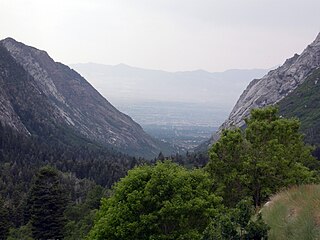
Little Cottonwood Canyon lies within the Wasatch-Cache National Forest along the eastern side of the Salt Lake Valley, roughly 15 miles from Salt Lake City, Utah. The canyon is part of Granite, a CDP and "Community Council" designated by Salt Lake County. The canyon is a glacial trough, carved by an alpine glacier during the last ice age, 15,000 to 25,000 years ago. A number of rare and endemic plant species are found in the canyon's Albion Basin. Mountain goats inhabit the surrounding mountains.
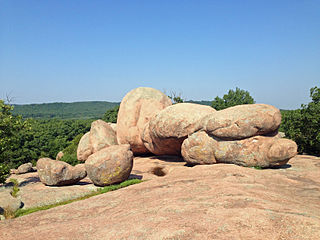
Elephant Rocks State Park is a state-owned geologic reserve and public recreation area encompassing an outcropping of Precambrian granite in the Saint Francois Mountains in the U.S. state of Missouri. The state park is named for a string of large granite boulders which resemble a train of pink circus elephants. The park was created following the donation of the land to the state in 1967 by geologist John Stafford. The park is used for picnicking, rock climbing, and trail exploration. It is managed by the Missouri Department of Natural Resources.
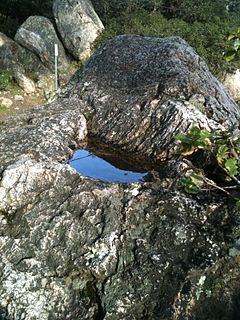
Indian Rock Park is a 1.18-acre (4,800 m2) public park in the city of Berkeley, California, on the slope of the Berkeley Hills. It is located in the northeast part of the city, about one block north of the Arlington/Marin Circle, and straddles Indian Rock Avenue. The central feature of the park is a large rock outcropping on the west side of Indian Rock Ave. The larger portion of the park, on the opposite side of the street, has several much smaller rock outcroppings, grass fields, and a small barbecue and picnic area.

The Needles of the Black Hills of South Dakota are a region of eroded granite pillars, towers, and spires within Custer State Park. Popular with rock climbers and tourists alike, the Needles are accessed from the Needles Highway, which is a part of Sylvan Lake Road. The Cathedral Spires and Limber Pine Natural Area, a 637-acre portion of the Needles containing six ridges of pillars as well as a disjunct stand of limber pine, was designated a National Natural Landmark in 1976.

Hole-in-the-Rock is a natural geological formation in Papago Park, a municipal park of Phoenix and Tempe, Arizona.
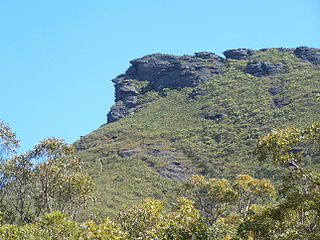
Granite outcrops of Western Australia are weathered landforms that occur throughout the state of Western Australia, composed primarily of the rock type granite. All recognised types of this landform can be observed, commonly as bornhardts, but also as inselbergs, castle koppies and Nubbins. Rising abruptly from the surrounding landscape they create a variety of microhabitats for plants, and provide seasonal resources and refuge for a range of animals. These areas thus have rich biodiversity and many endemic species. They are significant locations that tie in with the Aboriginal and European cultural heritage of Western Australia.

Mount Oglethorpe is a mountain located in Pickens County, Georgia, USA. The southernmost peak in the Blue Ridge Mountains, the mountain has an elevation of 3,288 feet (1,002 m), making it the highest point in Pickens County.

Rock Eagle Effigy Mound is an archaeological site in Putnam County, Georgia, U.S. estimated to have been constructed c. 1000 BC to AD 1000. The earthwork was built up of thousands of pieces of quartzite laid in the mounded shape of a large bird. Although it is most often referred to as an eagle, scholars do not know exactly what type of bird the original builders intended to portray. It is listed on the National Register of Historic Places (NRHP) because of its significance. The University of Georgia administers the site. It uses much of the adjoining land for a 4-H camp, with cottages and other buildings, and day and residential environmental education.

The Yellow River is a 76-mile-long (122 km) tributary of the Ocmulgee River in the U.S. state of Georgia.
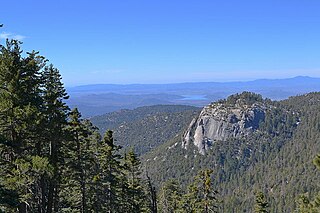
Suicide Rock is a granite outcrop near Idyllwild, California, which is popular with rock climbers. Over three hundred climbing routes have been described. It is located near Tahquitz Peak.
Stephens is an unincorporated community in Oglethorpe County, Georgia, United States. As of the 2010 census, the ZIP Code Tabulation Area for Stephens' post office had a population of 1035. The community of Stephens is located along State Route 77 between Maxeys and Lexington, at the intersection of Salem Road, which heads east through some rural and low-density residential areas and eventually on to State Route 22.
Bairdstown is an unincorporated community in Greene and Oglethorpe counties, in the U.S. state of Georgia.





















